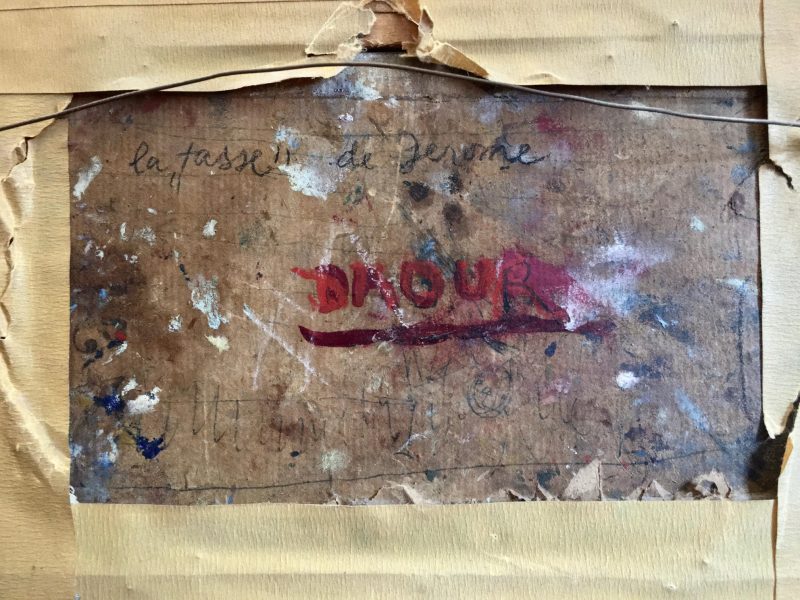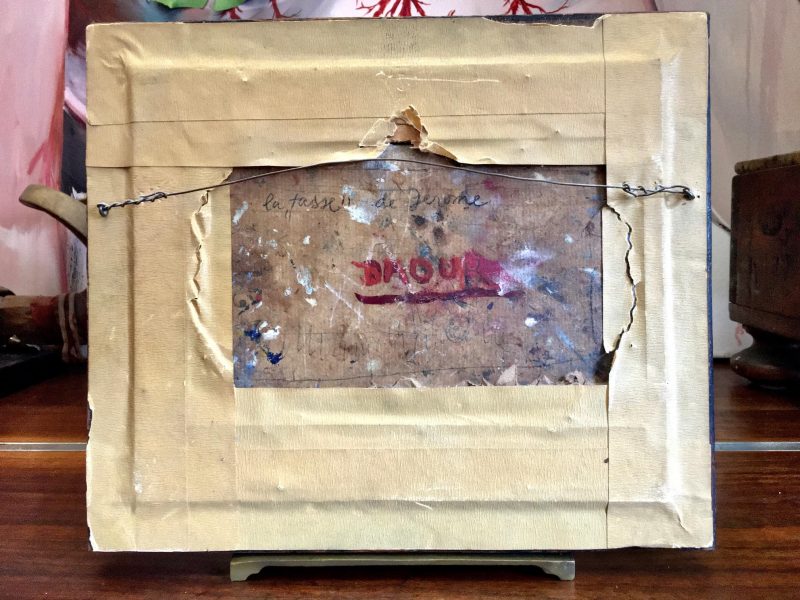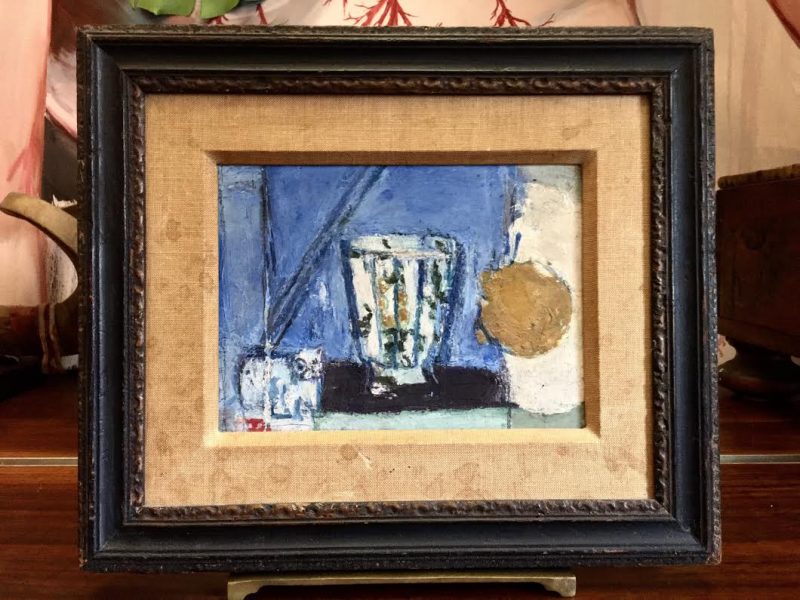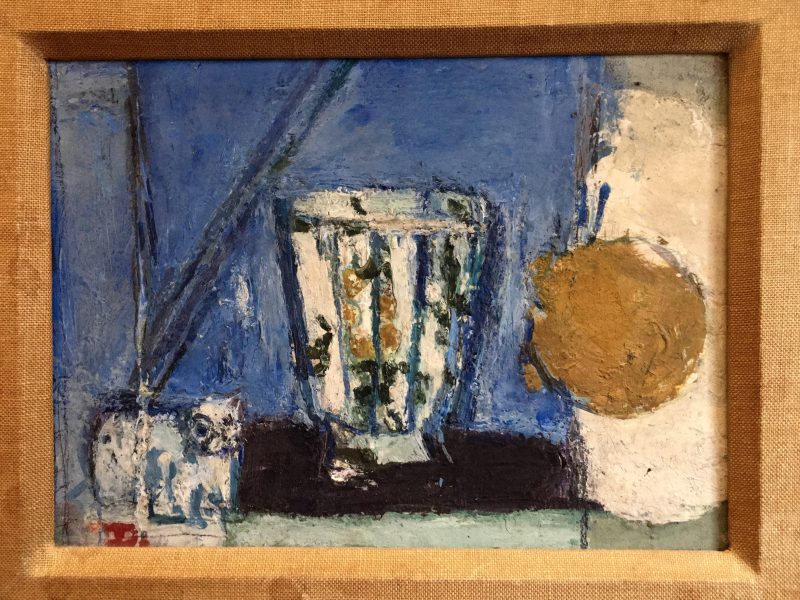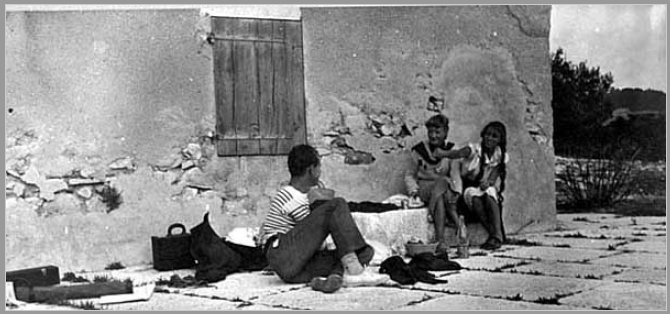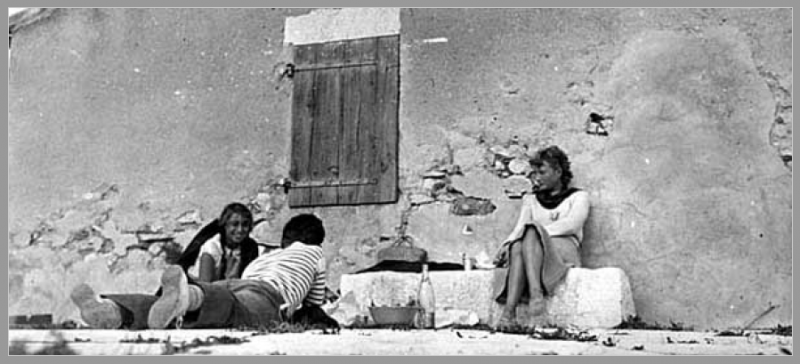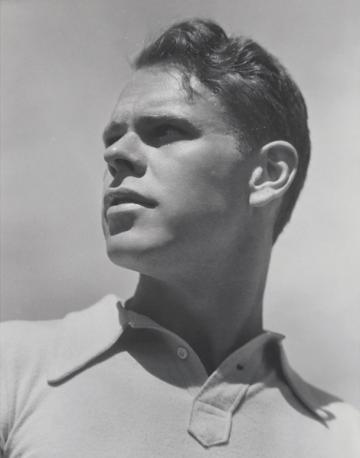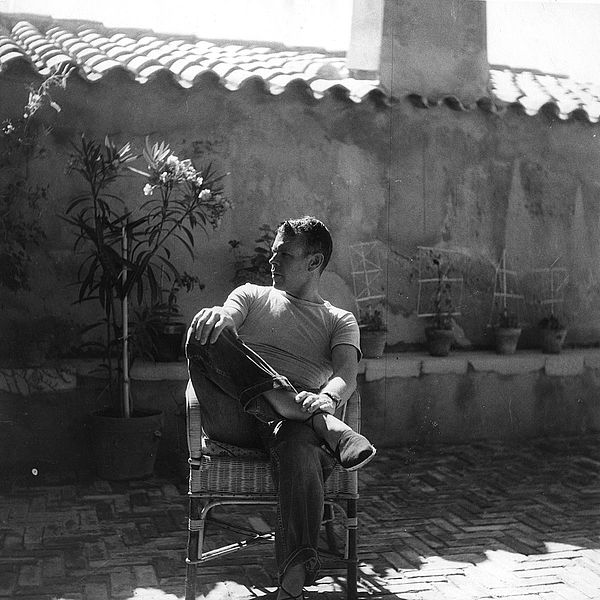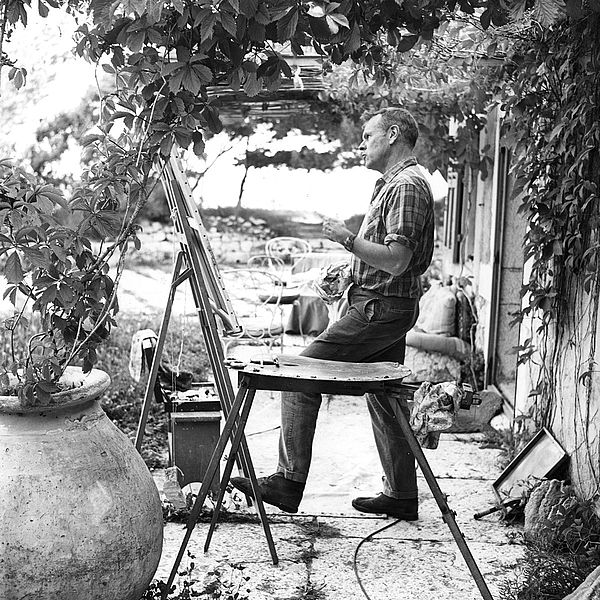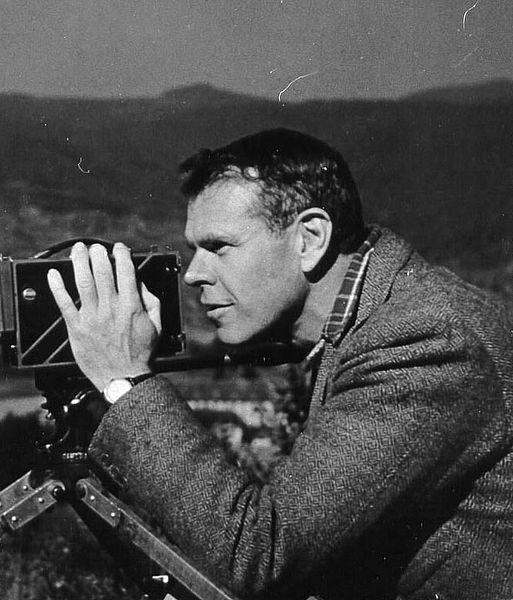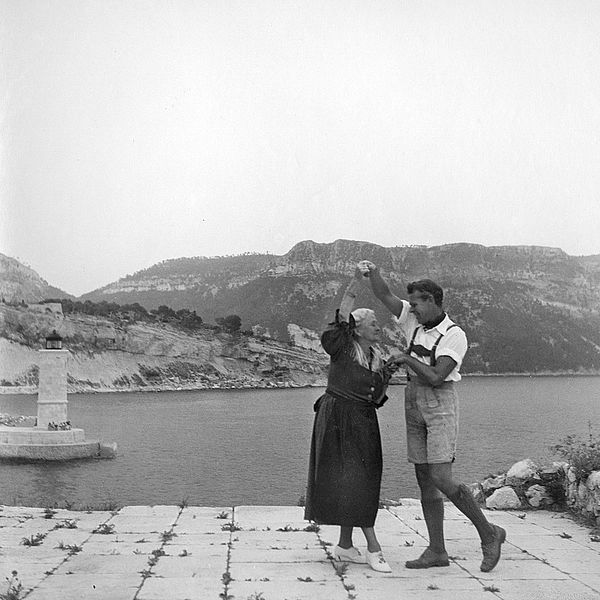“La Tasse de Jerome” Painting by Jeanne Daour Born 1914, Bucharest
“La Tasse de Jerome”, Modernist Painting by Jeanne Daour. Born Romania 1914.
Attributed/Referring to Jerome Hill, American (1905 – 1972), Oil on wood panel, 12.5 width x 11.75″ height (measurements with authentic frame), circa 1940’s.
USD$850
Jeanne Daour was a pupil of the Scandinavian academy in Paris (1930) and of the Colarossi Academy and after of the Fondation Camargue in Cassis, Jeanne Daour exhibited her work at the Salon des Tuileries in 1930 and in other Parisian Salons.
Paris in the first third of the 20th century was a magnet for artists from Eastern Europe and the United States. It was in Paris, probably at the Atelier Bonnat—and, oddly, among a substantial percentage of Scandinavian students—that Jeanne Daour met Jerome Hill. She had been born in Romania and he in the Midwest of the U.S., a grandson of railroad magnate James J. Hill. Hill befriended Daour and acquired a few of her paintings, acknowledging that her talent exceeded his own. Little biographical material on Daour is available, however, so it is difficult to place this painting in a larger context.
RESEARCH:
http://gehem.over-blog.fr/2019/02/jeanne-daour-3.html
http://gehem.over-blog.fr/2020/08/jeanne-daour-7.html
https://www.ebay.com/itm/JEANNE-DAOUR-Romanian-Modernist-Original-Signed-Oil-Bucharest-Street-Scene-/232545161910
https://www.1stdibs.com/art/drawings-watercolor-paintings/figurative-drawings-watercolors/jeanne-daour-billiard-room-original-china-ink-drawing-jeanne-daour-mid-1900/id-a_5063911/
https://www.artsy.net/artist/jeanne-daour
https://www.mutualart.com/Artist/Jeanne-Daour/CF3E4DB983FC5C0B
https://www.navigart.fr/fnac/artwork/jeanne-daour-nature-morte-140000000037030
More on Jerome Hill:
https://www.jeromefdn.org/founder
Jerome Hill, the grandson of railroad builder James Jerome Hill and the son of Louis W. Hill, Sr., was born and grew up in St. Paul, Minnesota. Manifesting an early interest in painting and drawing, Hill attended St. Paul Academy where, as a student, he decorated the walls of the chemistry laboratory with a series of historical murals which survive to this day. At Yale, where he majored in music, he created costumes and sets for the Dramat and drew for the Record. He studied painting at the British Academy in Rome and at the Academie Scandinav in Paris. His paintings and drawings have been widely exhibited and are included in several private and public collections.
During the 1930s in Cassis, where he went every summer to paint, Hill developed his interest in filmmaking. Using one of the first Cine-Kodak-Specials, he created a series of films experimenting with the language of cinema. After returning to the United States in 1939, he made two film shorts released by Warner Brothers.
Jerome Hill was also interested in still photography. Influenced by what he had learned as a student of Edward Weston, he undertook a photographic essay of a tour of Greece. This collection of stills was published in 1937 under the title Trip To Greece.
After World War II, during which he served in Army film units and as a liaison officer with French forces, Jerome Hill returned to film biographies. With Erika Anderson as cinematographer, he produced and directed a film short, Grandma Moses which was nominated for an Academy Award, and a feature length documentary, Albert Schweitzer, that received an Oscar in 1957. Dissatisfied with the narrow confines of documentaries, Hill made his first “story” film, The Sandcastle in 1959-60. Inspired by the ideas of C. G. Jung, it was a feature length, low-budget, comedy-fantasy in black and white with a dream sequence in color that introduced a novel form of stop animation.
Subsequent films included the full-length Open The Door also related to Jung’s thoughts; Schweitzer and Bach, and hand-painted animation shorts: Anticorrida, Merry Christmas, The Artist’s Friends and The Canaries. His full-length autobiographical film, Film Portrait, was selected as an outstanding Film of the Year for presentation at the 1972 London Film Festival and won the Gold Dukat Prize at the 21st Annual Film Festival in Mannheim.
In the late 1960s, Hill began to compose all of the scores for his films. Throughout his life an avid student and creator of music, his interest in later years was in composition of works for the harpsichord and small orchestra.
Jerome Hill’s support of artistic and humanistic endeavors is known on both continents. Through the years he gave financial assistance which enabled numerous artists and humanists to continue their work. In 1964, he set aside funds to establish the Avon Foundation, which since 1973 has been known as the Jerome Foundation.
//
MORE:
Jerome Hill and Charles Rydell
by Gary Comenas (2016)
Jerome Hill (b. March 2, 1905) was a filmmaker, painter and patron of the arts who, along with his younger friend Charles Rydell (b. October 28, 1931), was at one point part-owner of Andy Warhol’s Interview magazine.
Warhol biographer, Fred Lawrence Guiles, identifies Charles Rydell as Hill’s “lover.” (LB409) In a biographical essay about Hill published by the Jerome Foundation, art writer Mary Ann Caws notes that Hill handled his homosexuality “with great delicacy” and that his “sense of apartness” was “in large measure attributed to his sensitivity about his homosexuality.”
The Jerome Foundation
In 1964 Hill set up a philanthropic organization, the Avon Foundation, which was renamed the Jerome Foundation after his death. (MAC15) The Foundation continues to support the arts. In 2016 it helped to fund the New York Art Book Fair at which Jonas Mekas made an appearance on September 18, 2016.
Hill had a privileged upbringing. His grandfather, James Jerome Hill, created the Great Northern Railway and the First National Bank of Saint Paul. Jerome and his siblings were educated at home. His interest in filmmaking may have been influenced by the screening of films at the family home. His parents would show films at home because they had a “horror of the microbes that might be proliferating in public places, like movie houses.” (MAC6)
Hill’s “lover,” Charles Rydell, had anything but a privileged upbringing. According to Fred Lawrence Guiles, “When he was a small boy, Charles had been put in a boys’ home because his father was alcoholic and his mother and aunt were ‘thrown out of Pennsylvania because they were prostitutes.’ Some money was stolen and the head of the home wrongly accused Charles and then he had to run a gauntlet of paddles. He never got over his sense of injustice.” (LB229-231)
It’s unknown when Rydell and Hill met but they certainly knew each other by 1950 as Jerome took this picture of Charles at that time.
According to Guiles, Warhol first met Rydell through fellow Carnegie Tech alumni, Victor Reilly. Both Reilly and Rydell were on hand when Warhol arrived in New York:
Fred Lawrence Guiles:
One of his [Warhol’s] old friends from Carnegie Tech’s modern dance group, Victor Reilly, met Andy within hours of his arrival at Penn Station. And actor friend, Charles Rydell, accompanied him, and Andy made no secret of the fact that the thought Rydell was sensational-looking. He was tall, wavy-haired, broad-shoulderd, with a strong resemblance to the young Charlton Heston, except that Rydell’s features were much more refined. Within a few years Rydell was in the off-Broadway musical The Threepenny Opera, and in the 1960s he was cast as Hercules in the Broadway musical By Jupiter. (LB49)
Guiles also quotes Rydell as saying, “At Andy’s memorial service, I told somebody that I met Andy on his first day in New York and that he was so boring I didn’t see him again for ten years. I was just joking…” (LB50)
It’s interesting that Guiles says that Reilly was in Carnegie Tech’s modern dance group as other biographers have indicated that Warhol was the only male member in the group. When Warhol first moved to New York in 1949, he lived with fellow classmate Philip Pearlstein but by August 1950 he was living with Victor Reilly and other classmates from Carnegie Tech in a house at 74 West 103rd Street. (See “74 West 103rd St.”)
According to Guiles, Rydell appeared in a production of Threepenny Opera in 1954 and that Warhol was still involved with the amateur drama group, Theatre 12, at that point.
Fred Lawrence Guiles:
…Kurt Weill and Brecht’s The Threepenny Opera was one of off-Broadway’s biggest hits at the Theater de Lys on Christopher Street, a short distance from Theater 12. The Brecht-Weill collaboration opened in 1954 while Andy was still involved with the group, and ran for six years. One of his close friends, Charles Rydell, was appearing in it, and it was a “must see” for everyone in town. (LB106)
The meeting of Rydell and Warhol is recounted slightly differently in Popism. Rydell’s name first comes up in regard to a screening of Warhol’s film Tarzan and Jane Regained, Sort of… in Jerome Hill’s suite at the Algonquin Hotel in Manhattan in 1963. Rydell was at the screening and Warhol recalled that he had met him earlier through someone named “Nancy March.” The name “Nancy March” could be a pseudonym as she is not mentioned elsewhere in the book or in any Warhol biographies. “Nancy” was sometimes used as slang for a homosexual.
From Andy Warhol and Pat Hackett, Popism: The Warhol Sixties (NY: Harcourt Brace, 1980), p. 46:
A young actor by the name of Charles Rydell was at that Tarzan screening. We had a mutual friend named Nancy March who’d introduced us in the pouring rain on my first day in New York years before. Charles has been working in Nedick’s then, and I was just off the bus from Pittsburgh, but I hadn’t seen him – at least not to talk to – since. However, I’d happened to catch his performance in Lady in the Dark with Kitty Carlisle at the Bucks County Playhouse, and I told him so right away. He thought I was putting him on – he looked at me as if to say, “Oh, come on – nobody saw me in that.” He was a very big man with a big temper and a great sense of humour. He could really bellow, and he had the deep full voice to do it right. At the Tarzan screening there was a fat guy named Lester Judson who every couple of minutes would point at the screen and say, “This isn’t a movie – it’s a piece of shit! You call this a movie?” Finally Charles got fed up and almost blasted him off the chair with “Oh, shut up, Lester! Here you’re putting it down and this whole underground thing is just trying to get started!”
I liked Charles and I asked if I could call him to be in a movie of mine. He said sure, any time.
Later, Rydell consented to be in Warhol’s film Blow Job, but he thought Warhol was joking when he suggested it and never showed up for the shoot.
Interview magazine
Rydell and Hill became part-owners of Interview magazine in 1970. Bob Colacello had recently been promoted to editor of the magazine and the first issue he edited was devoted to Rita Hayworth. After supervising the printing of the issue and distributing it to places like the lobbies of MoMA lobby, the Anthology Film Archives and shops like Cinemabilia and the Memory Shop, Colacello went to Warhol’s office to give him some copies to take to dinner. Warhol invited him to the dinner so that he could meet the “new owners” of Interview.
Bob Colacello:
I went… to give Andy a few copies to take to dinner. “Gee, thanks,” he said. “Uh, maybe I should take you to dinner. It’s Jerome Hill and Charles Rydell. Uh, they’re the new owners of Interview.”
The new owners?
“Uh, I mean, they own part of it now. I think.”
“But I’m not really dressed for dinner.”
“Yes you are. Gee, that’s such a pretty striped polo shirt. Did your mother get it for you at Saks?”
“Yes, but don’t I need a tie and jacket?”
“Uh, it’s at the Algonquin and they uh live there, so you can wear one of their jackets and uh ties.” (BC41)
The first issue of Interview magazine that Bob Colacello edited – the Rita Hayworth issue (Vol 1. No. 11) (1970)
Colacello continues with a description of his evening with Hill and Rydell – a dinner that also included Taylor Mead, Sylvia Miles, and Hill’s nephew, the photographer Peter Beard.
Bob Colacello:
We finally reached the Algonquin, thank God, and went upstairs to the suite that Jerome Hill, the elderly heir to the Northern Pacific railroad fortune, kept for the times he came into the city from his farm in Bridgehampton. We were greeted by Jerome’s long-time best friend, actor Charles Rydell. Before Andy could introduce me, Charles bellowed, “I know who he is! And I’ve seen his first issue. I hate it. All those Rita Hayworth stills are so goddamn campy. Brigid brought it up to me this afternoon. She was going to stay for dinner until she heard you were coming, Andy.” I hadn’t met Brigid Berlin yet because she and Andy were fighting then. “Come in, Robert,” bellowed Charles, “I don’t really hate your first issue. It’s just that Brigid was ranting and raving against all the campy faggots and she got me going. Let me introduce you to Jerome. He’s the real genius in this room. Not the fruitcake you came in with.” Then he bellowed out a giant laugh.
Jerome Hill, I soon learned, was not only part owner of Interview and a patron of the arts but also an artist himself, who painted École de Riviera landscapes at his summer house near Cannes, and directed documentaries about growing up rich in the Middle West. Above all he was a gentleman, simple and kind. He loaned me a jacket and tie, and, even thought the jacket was two sizes too large and the paisley tie clashed with my striped shirt, I began to feel more comfortable in this strange new world. Then I met the rest of Charles and Jerome’s Algonquin round table.
First came Taylor Mead, another sometime Superstar who had fallen out with Andy. Like Jerome Hill, he was the scion of a major Middle Western industrial fortune, but a gentleman, simple and kind, he was not. He looked like a Bowery bum and talked like a Village waif. He spent most of dinner staring suspiciously across the table at me.
Then came Sylvia Miles, spouting the box-office figures of Midnight Cowboy, the hit film of the moment, in which she played a hooker with a heart of brass. Andy resented the success of the John Schlesinger film. He said it was a “rip-off” of Flesh, and that Schlesinger wasted the Factory’s time for days shooting the party scene and then cutting it to shreds.
“Andy,” rasped Sylvia, “I loved Joe Dallesandro in Trash. I was thinking, we should really work together. In fact, I’ve got a script right here in my bag that would be perfect for the two of us. I’m carrying it around because I just came from a drink with my agent, Billy Barnes – you know Billy, he handles Tennessee – and he wanted to discuss it, and then when I told him I would be dining with you later in the evening he said…”
“Oh, uh, you should talk to Paul,” said Andy.
Finally with the third round of cocktails came Jerome Hill’s nephew, Peter Beard. With his wife, Minnie Cushing, of the Newport Cushings. And their pet snake, all coiled up in Minnie’s large straw bag. They were just back from their honeymoon in Kenya and looked as if they hadn’t had time to change their clothes. Peter wasn’t even wearing socks, and this was November in New York.
“Aren’t they beautiful?” Andy whispered. “Don’t you wish you could be that beautiful?”
“Oh, Andy,” bellowed Charles, “stop acting like such a goddamn fucking faggot. No wonder Brigid can’t stand to be around you anymore.”
Andy said Charles was just being nutty, Sylvia said she had a great idea for a movie starring Charles and her, Peter passed around his latest photographs of dead elephants, Minnie patted her snake, Taylor stared suspiciously, and Jerome asked me if I’d like another drink. “Yes, ” I said. “A double vodka on the rocks, please.”
I don’t remember much more about that first dinner party, except that Andy started taking Polaroids of the eager Greek waiter and Charles proposed that we all – including the waiter and the snake – go back to Jerome’s suite, whereupon Sylvia announced that she had an early script meeting with a major director and needed me to escort her home. I gave Jerome his jacket back, but he insisted I keep the tie, which I still have, a souvenir of the beginning of a decade of dinner parties in hotels around the world. Somehow I hailed a taxi, dropped Sylvia off on Central Park South – “Tell Paul to call me about the script Andy wants him to read” – and made it home to my furnished room.
At precisely nine the next morning, Andy called. “You were a bit hit with Charles and Jerome, ” he said. “Isn’t Peter great-looking? And it’s great the way he talks so fast. Except I never know what he’s talking about. Do you think he has a problem?” Eventually he got to Interview. “It was pretty good,” he said. “But maybe Charles was right. Doing just Rita does look too campy. But then Charles is the biggest camp of all, right? So I never know.” (BC42-43)
The photographer, Peter Beard, mentioned in the above quote was actually Jerome Hill’s cousin, not his nephew, according to a biographical essay published by the Jerome Foundation. (LA10)
Hill and Rydell’s involvement with Interview didn’t last long. According to Bob Colacello in the chapter of his book, Holy Terror, that covers 1971, Fred Hughes “was secretly negotiating the sale of the Jerome hill and Charles Rydell shares to Peter Brant and Joe Allen, his new best friends – and Andy’s new best clients. Peter Brant and Joe Allen were in their twenties and ran their fathers’ rapidly expanding newsprint company. Bruno Bischofberger, Andy’s new Swiss art dealer, was also part of the complicated transaction, which involved the exchange of paintings, the publication of the Electric Chair prints, tax write-offs – a typical Fred Hughes deal. And Fred’s name went on the masthead as editor, above those of Paul Morrissey and Andy Warhol.”
Warhol, Taylor Mead and other Warhol stars also visited Hill and Rydell at their home in Bridgehampton. Gerard Malanga refers to a visit there in the summer of 1971 in the description of a photograph on the Christie’s auction house website. Malanga is quoted as saying, “We took the train to Bridgehampton to visit our friends Jerome Hill and Charles Rydell at Hill’s home, ‘Windy Hill’. Taylor Mead (who starred in several films by Warhol and other ‘underground’ filmmakers) is sitting in a chair, waiting for his close-up, and I’m coming through the door, clutching my Nikon in one hand and something else — maybe another camera — in the other. Paul Morrissey was there, too.” (“Gerard Malanga on Polaroid — ‘The Friendly’ Camera”)
When in Manhattan, Hill and Rydell lived at the Algonquin and continued to host dinners there. Bob Colacello recalls that Hill hosted an “off-to-Cannes” party there in May 1972. (BMB496) (BC112)
Colacello writes, “Parties, parties, parties, all winter, all spring, all night” before going on to describe the premiere of Cabaret, the premiere of Holly Woodlawn’s film A Scarecrow in a Garden of Cucumbers and then Jerome Hill’s “off-to-Cannes” party at the Alonquin.
Bob Colacello:
Jerome Hill’s off-to-Cannes party at the Algonquin, where Andy, William Burroughs, Terry Southern, and Larry Rivers sat in a row, like some Mount Rushmore of Hip, and Brigid Berlin burst in with a radio broadcasting Nixon’s massive bombing of Hanoi. Everybody said it was the end of the world, except Burroughs, who had already passed out, and Andy who was deep into dessert – a “snowball” of ice cream covered in coconut and vodka. (BC112)
Jerome Hill Films
Hill was off to Cannes because his film, Portrait (aka Film Portrait) was going to be screened at the Festival de Cannes. The film had been chosen to be part of the “Directors’ Fortnight” lineup that year. (Hill also owned property in Cassis in the south of France – see below.)
The B.F.I. lists Hill as the director of the following films:
Grandma Moses (1950)
Albert Schweitzer (1956)
The Sand Castle (1961)
Open the Door and See all the People (1963)
Death in the Forenoon or Who’s Afraid of Ernest Hemingway? (1966)
The Canaries (1968)
Merry Christmas (1969)
Film Portrait (1972)
In addition to the Cannes tribute, Film Portrait was also selected as “an outstanding Film of the Year for presentation at the 1972 London Film Festival and won the Gold Dukat Prize at the 21 st Annual Film Festival in Mannheim.” (MAC9) Art writer, Mary Ann Caws describes the film:
Mary Ann Caws (Jerome Hill: Living the Arts, Jerome Foundation, 2005, p. 21):
The film seems to speed by, reflecting one of Jerome’s tenets for vitality in his work: for him, everything that flutters seems full of life, as opposed to what is static. All the different aspects of his life, some filmed by others, some by himself, compose this portrait. It is clearly not meant to be an autobiography of the usual sort, in which the moments would be presented in a more chronological order. It is a portrait of himself in a moment, and at moments – more than an evolution of a personality. In this experimental film, which is widely accepted as a masterpiece of the avant-garde, the avant-garde filmmakers with whom he associated, in particular Brakhage and Broughton, were highly influential.
Hill’s films were documentary in nature, often employing experimental film techniques. His short documentary, Grandma Moses, was nominated for an Academy Award in 1949. (MAC9) Another documentary, Albert Schweitzer, received an Academy Award in 1957. (MAC10)
Caws notes that “From 1956 to 1960, Jerome made the semi-narrative film The Sand Castle, based on the ideas of Carl Jung. Subsequent films included the full-length Open The Door and See All the People, also related to Jung’s thoughts; and four hand- painted animation shorts, Anticorrida, Merry Christmas, The Artist’s Friend, and Canaries. (MAC10)
Hill’s film, Death in the Forenoon or Who’s Afraid of Ernest Hemingway, also incorporated animated figures.
Village Voice ad for a screening of Hill’s film in the December 14, 1967 issue, p. 48
Nanci Bialler reviewed the film in the Vassar College newspaper.
Nanci Bialler (“Underground Movies, Mekas Films Varied, Absorbing,” Vassar Miscellany News, vol. LI, no. 23, Poughkeepsie, NY, May 3, 1967:
… Death in the Forenoon, or Who’s Afraid of Ernest Hemingway, by Jerome Hill, was a clever and slick combination of photography and animation. To a thirty-year-old film of a bullfight, Hill added semi-abstract animated figures who dashed about the ring trying to shield the bull from the matador. In his use of vivid colors, rinky-dink music, and sparclty of animation, Hill set a furious pace which transformed the slow stateliness of a bullfight into a light comedy. He mocked both the institution of bullfighting and the efforts of the pseudo-Humane Society.
In addition to his filmmaking, Jerome was also an accomplished painter, particularly while residing at his home in Cassis in the south of France.
Cassis
In 1939, Hill purchased a property known as “La Batterie” in Cassis, France. Eventually he also bought the building across the street – formally known as the Hôtel Panorama. (MAC8)
Cassis had been recommended by one of his teachers, Othon Friesz, at the Académie Scandinave in Paris where Hill had studied painting for three years. Jerome had graduated at the age of 17 from the Saint Paul Academy and then, for five years, attended Yale where he studied music. After Yale, he went to the British Academy of Painting in Rome for two years before enrolling at the Académie Scandinave. (MAC6)
Othon Friesz described the geography of Cassis as an “alternation of layers of stony chalk and gravel forms, thanks to the declivities, breaks, and geologic slidings, recognizable silhouettes of all shapes and sizes. What shows up “large on the slopes of Cap Canaille is repeated on the cliffs of the Château de Cassis as well as on the rocks of Bestouan. Everywhere there is a single theme, richly varied. From the summit of the mountains (right after Carpiagne, and before the descent into the amphitheatre where Cassis is situated), the immense sweep of waves of stones appears in all its majesty… (MAC7)
Hill organized a festival in an amphitheatre in Cassis on a regular basis. According to the author of The Living Theatre: Art, Exile, and Outrage, the amphitheatre was “built by Jerome Hill.” Originally called the Theatre de la Mer it later became known as the Jerome Hill Greek Theatre.
Mary Ann Caws recalls, “In that theatre, he arranged over the years, for an elaborate Cassis town festival. Over and over, the theatre was used, for Shakespeare’s The Tempest and other spectacles… Once he arranged for an appearance by The Living Theatre with Julian Beck and Judith Malina.” (MAC14)
The Living Theatre
Theatre de la Mer (Jerome Hill Greek Theater), Cassis, France (MAC5)
The Cassis performance of The Living Theatre is the one that took place in late July 1966 which was famously heckled by Warhol star Taylor Mead.
From The Living Theatre: Art, Exile, and Outrage (London: Methuen Drama, 1997) by John Tytell:
In July, the [Living Theatre] company drove through the Alps, returning to Reggio Emilia to continue working on Frankenstein and to spend the hot nights under mosquito netting. At the end of the month, after packing the sets of The Brig and Frankenstein, the company boarded their old, beat-up buses for a long drive along the Mediterranean coast to Cassis in Provence. There, they were met by poet Taylor Mead and the film maker Jonas Mekas, and quartered in unfinished buildings meant for French Algerians. In the nagging wind of the mistral – reputed to drive people mad – surrounded by stone-pocked hills, they performed Mysteries under the sky in a stone amphitheatre built by Jerome Hill, their host, the black sheep of an American railroad family, who had given the company $20,000 to help pay for their 1962 European tour. Taylor Mead found the performance “communal to the point of sameness.” He was irritated by the frequency with which Julian kept repeating “End the war in Vietnam!” and began shouting “A bas les intellectuals!” and “Vive la guerre de Vietnam!” in response.
Under a full moon, near the sea, they did an extravagant five-hour version of Frankenstein. The local newspapers parodied the company, maligning them with implications of drug use, but the curious audiences still came. As usual, there were supporters as well as unsympathetic observers, one of whom filled a hubcap with gunpowder and left it under one of the buses. Fused and detonated, it fortunately did little damage but existed as an ominous sort of warning.
The organizers of the festival at Cassis permitted the company to stay on for an additional three weeks, and in the middle of August, with the mistral wind bending the trees and one of the buses leaking oil because of a faulty piston, they drove to Berlin. (JT216-17)
Jerome Hill and Jonas Mekas
Jonas Mekas later recalled filming the Living Theatre’s performance of Mysteries at Cassis, although he didn’t release the film at the time.
Jonas Mekas:
I filmed The Living Theatre’s Mysteries in 1966, at the Festival de Cassis, organized by Jerome Hill. I didn’t like the results and I never released the film, but I always liked the segment based on MacLow’s script. Maclow’s version differs slightly from The Living Theatre’s version. You can find MacLow’s script in Kastelanetz’s anthology called Scenarios. MacLow says he wouldn’t have said some of the things the Living Theatre said. Noel Burch helped me to record the sound. (JMF)
Mekas later released at least some of the Living Theatre footage in his film, Street Songs (1966/1983) which is currently available from the Film-Makers’ Coop. (JMF)
Hill also appeared in a number of films by Jonas Mekas: In Between: 1964 – 68 (1978), Birth of a Nation (1997) and Notes for Jerome (1978). Mekas describes Notes for Jerome as follows:
Jonas Mekas:
During the summer of 1966 I spent two months in Cassis, as a guest of Jerome Hill. I visited him briefly again in 1967, with P. Adams Sitney. The footage of this film comes from those two visits. Later, after Jerome died, I visited his Cassis home in 1974. Footage of that visit constitutes the epilogue of the film. Other people appear in the film, all friends of Jerome: Taylor Mead, Bernadette Lafont, Charles Rydell, Barbara Stone and David Stone and their children; Noel Burch, Judith Malina and Julian Beck and the Living Theater collective, Ms. Chaliapin, Jean Jacques Lebel, Michael Fontayne; Alec Wilder, P. Adams Sitney and Julie Sitney and Jerome’s perhaps closest and oldest friend, whose name I forgot, but whom he always called Rosebud. The soundtrack was practically all recorded during the same period, during the same visits to Cassis. Piano improvisations are Jerome’s and Taylor Mead’s; the soloist (Monteverdi’s ‘Lasciatemi morire!’ and Giordani’s ‘Caromioben’) is Charles Rydell’s practicing, in Cassis; the ocean and most of the wind is the late summer mistal; and so are the cicadas, street music, scooters, motorboats, birds, and my own sing-songing. The text of my Lithuanian ‘song’ is, in translation, ‘the sun is setting, the sky is red, I am sitting by the sea and I am singing by myself.’ Those were lonely summers for me, I thought a lot about home. That’s why this film, this elegy for Jerome is dedicated ‘to the wind of Lithuania.’ Sometimes, though, I had a feeling that Jerome was as much of an exile as was I. (JMF)
Mekas also shot a 4.5 minute film in Cassis called Cassis (1966) which is described in the Film-Makers’ Coop catalogue as “A small port in South of France, a lighthouse, the sea, shot from just before the sunrise until just after the sunset, all day long, frame by frame, a frame or two every second or every few minutes.”
Hill and Mekas were connected both artistically and financially. Film scholar, Paul Arthur, writes in his essay “Routines of Emancipation: Alternative Cinema in the Ideology and Politics of the Sixties” that “Mekas relied on several ‘angels’ such as Jerome Hill and publisher Harry Grant to underwrite the costs of commercial space or the printing of Film Culture, but virtually all outside funding was garnered ad hoc.” (DJ26)
Film Culture was the film magazine that Mekas published and the “costs of commercial space” were presumably related to Mekas’ various cinematheques and his the Film-Makers’ Cooperative during the 60s. (See “Jonas Mekas and the Film-Makers’ Cinemathque.”)
In 1970 Hill was involved in the founding of the Anthology Film Archives with Mekas. According to film scholar, David E. James, the Anthology was to be “a permanent home where the classic works of film could be shown on a regular basis. Jerome Hill, P. Adams Sitney, Peter Kubelka, Stan Brakhage, and Mekas himself drew up plans for such a museum, to be called Anthology Film Archives. A selection committee made up of James Broughton, Ken Kelman, Peter Kubelka, Jonas Mekas, and P. Adams Sitney were to establish ‘The Essential Cinema,’ a permanent collection of “the monuments of cinematic art.’ Unlike Mekas’ previous screenings, the Anthology was from the beginning critical and discriminatory.” (DJ12) (See also: “Jonas Mekas and the Film-Makers’ Cinematheque,” p. 6.)
Jerome Hill R.I.P.
Jerome Hill (1931) (Photographer: Edward Weston)
Collection Center for Creative Photography, University of Arizona © 1981 Arizona Board of Regents (MAC)
(“Living the Arts,” Jerome Foundation, 2005)
Two years after the founding the Anthology Film Archives, Jerome Hill died at St. Luke’s Hospital on November 21, 1972. He was sixty-seven years old. (MAC17) Charles Rydell retreated to the Hamptons but later returned to New York and appeared in video projects by Andy Warhol and Vincent Fremont.
After Jerome’s death, Jonas Mekas paid the following tribute to him in the Village Voice, December 7, 1972 and re-published it in the No. 56-57 (Spring 1973) issue of Film Culture:
A POET IS DEAD (IN MEMORY OF JEROME HILL) by Jonas Mekas
Only four weeks ago, Jerome Hill’s film ‘Film Portrait’ was screened at the Museum of Modern Art, and he was there himself to talk, to answer questions. He was thin and white. Very few people knew it, but he knew it, and his close friends knew it: Jerome has been ill, very ill. He collected his strength to come to the screening, to see his friends, to see the screen sing for the last time. The film was beautiful, the projection was beautiful, and the screen sang. Jerome received an enthusiastic and warm reception for his film. It was a perfect, beautiful crowning of a very humble life of a very great artist.
No, Jerome Hill didn’t receive proper recognition during his life. From his friends, yes: Stan Brakhage, Peter Kubelka, P. Adams Sitney, James Broughton, a few others saw his work and praised it and told him what a great artist he was. ‘Film Portrait’ will remain among the masterworks of cinema-a masterwork of form, of treatment of an era, an extraordinary work of animation and color. I cannot go into all its values and all its beauties here. But the film critics, during his life, they looked at Jerome, they looked at his work, and they could’t see it: they saw his grandfather’s railroads behind him, instead; they discussed the railroads, and the money, and they missed the colors and the movements and the glories of cinema. And so one more artist is gone, and now we can begin to praise his work! Will it always be the same? Why can’t we praise our living artists! No, Jerome won’t add a single frame now, he made his last film.
One of the extraordinary things about Jerome was that while everybody around him was getting older with the years, Jerome seemed to get younger and younger. His work got younger and younger every year. His cinema began at Warner Brothers, and it ended in the lines of avant-garde film. His progress was slow and painful. He had to free himself from many society, family and commerce traditions. But he was freeing himself and opening himself continuously, until, in the early ‘60s, his search brought him into the lines of the avant-garde film. After that, he seemed to discover his own style, and he threw himself into the making of the ‘Film Portrait’, his crowning achievement. His films and his paintings exploded with little bursts of ecstasies.
Simultaneously with his own creative work, he became very sensitive to the creative work of other film artists and he did everything to assist their work. Probably nobody will ever know the extent of help he has given to independent film-makers; because of his humility, practically all help was given anonymously. But I can tell you this much, that neither the Film-Makers’’ Cooperative nor the Film-Makers’ Cinematheque nor Film Culture magazine nor the Anthology Film Archives would exist or be what they are, if not for the kind help of Jerome Hill, who came always just at the right time, whenever our heads were sinking below the water line; without pampering-but never letting us down in real need. The whole movement of the American avant-garde film of the ‘60s would have taken a completely different turn, much slower and thinner, without the help of Jerome. I am not writing here a history of the American avant-garde film; I am writing a last tribute to Jerome. So I am talking in very general terms, and I am skipping details and names and figures. But when such a history is written, that history will be dedicated to Jerome Hill.
But now Jerome is gone, his body. The American avant-garde film is a chapter in the history of cinema, a fact of cinema, a reality of cinema that cannot be turned back. The cinema will never be the same again. And a long line of works of great beauty has been created. A form of cinema exists vaguely known as the avant-garde film, that will have to be discussed, analyzed, taken into account by whoever makes cinema, teaches cinema, or looks at cinema. Will there be another Maecenas for the art of cinema, for avant-garde film? Will there be anyone to whom we’ll be able to turn in real need? The creation of art and the Maecenas of art go hand in hand. An artist, in order to create, doesn’t need a wide acclaim and a wide audience: give him two or three friends, one critic, and one Maecenas, and he’ll produce great works and he’ll expand the vision and ideals of humanity.
Yes, it’s very possible that we are at the end of a great period of creativity in American cinema; it’s very possible that Jerome Hill’s death marks the beginning of another stage of the American avant-garde film: the stage of preserving for posterity what has been created. It was the genius foresight of Jerome that he thought about that too: during the last three years of his life he put himself completely behind the creation of the Anthology Film Archives, a place in which the works of American avantgarde film-makers can be preserved and seen in their full glory. Yes, even here, Jerome was younger than many of us: he was in the future. He knew that it’s not enough to create, no: taking loving care of what has been created, taking care of the flowering fruits of the human spirit, which is art – he knew that that was the other side of the matter, and they both made One. Such was the work and wisdom of Jerome Hill. But death has its own wisdom. Jerome Hill died on November 21, in the afternoon, in St. Luke’s Hospital. Upon his wish, he was cremated. A small funeral service was held for family and friends at St. James’s Episcopal Church, Madison Avenue at 72nd Street, at noon on November 24.
By the time of Jerome Hill’s death, Warhol had known Charles Rydell for a considerable time. According to Fred Lawrence Guiles, Rydell had been one of Warhol regular telephone conversationalists of the 1960s. Guiles suggests that Warhol’s obsession with talking on the phone may have had to do with the fact that Warhol was taking pharmaceutical “speed,” Obetrol. According to Guiles, “If he believed that his reality was ‘half television’ and not quite real, the Obetrols did not help except to screen out the humdrum element of his working life. He was also on the phone several hours every day talking to Henry Gleldzahler or the Duchess [Brigid Berlin] or Charles Rydell.” (LB196) if Rydell was one of Warhol’s regular phone mates, he may have been one of the unnamed “B’s” in Warhol’s Philosophy book.
Charles had also helped Taylor Mead, Brigid and her sister Richie when Jerome was still alive by giving them money and sometimes providing them with a place to stay.
Fred Lawrence Guiles:
Charles smiled as he recalled how a kind of ‘Reaganomics’ existed around the Factory. Andy never paid his film Superstars and players anything, so they were always in need of funds. Charles helped Brigid Polk with money and put her up at his small apartment at 20th and Park frequently. She and her sister Richie had their photos posted at the cash registers in Bloomingdale’s, so when they were out of funds, they had to cadge meals and pocket change from Charles. He put up Taylor Mead on occasions and helped him out. So the system worked this way: Charles was being kept by the filmmaker and railway scion Jerome Hill, and Charles in turn often kept Brigid and Taylor. (LA230)
Warhol made reference to these “hand-outs” to Brigid in his diaries in 1978:
Andy Warhol (Monday, December 18, 1978):
Brigid’s down to 140 and looks good. Charles Rydell is staying at her apartment and she’s so mean to him. She really is mean. He can’t watch her TV, he can’t put his feet up, he cant go to the bathroom. After everything he’s done for her – I mean, he gave her handouts for years. (AWD264)
But Charles wasn’t so kind to Brigid’s short-term gay husband in the ’60s. Guiles notes “Brigid Polk [Berlin] was married briefly to a man who preferred booze and other gentlemen to herself. He often wound up the night curled up asleep in front of Charles Rydell’s door, but Charles rarely took him in unless it was freezing.” (LB172)
Charles Rydell Films
After Jerome Hill’s death, Rydell eventually returned to New York and appeared in some of Warhol’s video projects such as Factory Diaries and Fight with Brigid Berlin.
Fred Lawrence Guiles:
As the seventies waned, Andy’s reputation was in semi-eclipse. He began doing other things as well as art… This time he turned to TV rather than film. He thought it would be fun to do his own situation-comedy rather like The Bickersons, a quarrelsome couple in the mid-fifties that had a run of about two years on the radio and, more briefly, on television… He asked Charles Rydell to come out of his semi-retirement in the Hamptons, where he had retreated following the death from cancer of his lover Jerome Hill. He knew that Charles was always in some sort of dispute with Brigid Polk [Berlin], and he also knew that Charles was one of the mainstays in her life, keeping her afloat in difficult times. Andy saw their relationship as akin to that of the Bickersons.
He put Vincent Fremont in charge of pulling it together, and Ronnie Cutrone was asked to help out as well. Cutrone had missed out on the Bickersons because of his youth, but he remembered Jackie Gleason’s The Honeymooners, in which the couple fights all the time, so he could relate to what they were doing. As Cutrone remembered it:
“Brigid and Charles were roommates and both of them were trying to diet, but neither of them could, and they were both cheating [on their diets], and they would fight and torture each other, about dieting primarily, you know, politics, whatever the situation called for. And every time Charles would get totally furious with her instead of going like, ‘Alice, POW to the moon!,’ he would grab this thing that was called the bull-worker, which was an exercise tool.”
Charles recalled that the weapon was something like a baseball bat:
“I was in therapy at the time, and I was supposed to take this thing and whenever I got really angry, I would vent my anger on the mattress of the bed, pounding the shit out of it. Just total hostility… getting it out of my system.”
They shot the series in various apartments, and there would be the people residing there drawn into the action, so the plot was very loose.” (LB409-410)
Fight is catalogued in the Other Voices Other Rooms exhibition catalogue as:
Fight
1975 – 1/2″ reel-to-reel videotape (7 total), b &w, sound, 00:30:00 each – Produced and directed by Andy Warhol and Vincent Fremont. With Brigid Berlin, Charles Rydell, Aage Bjerring, Sylvia Miles. (OV02:13:00)
It’s described as “a brilliant and hilarious improvised attempt at distilling a couple’s relationship (Berlin/Rydell’s or Miles/Rydell’s) down to their incessant needling and arguing.” (OV02:13:00)
In 2010 there a special screening of Fight scheduled at The Warhol museum, with personal appearances by Brigid Berlin, Charles Rydell and Vincent Fremont.
In addition to appearing in Fight, Rydell also appeared in a Factory Diary during the 1970s known as Hotel Room.
The video is catalogued as the following:
Factory Diary: Brigid Berlin, Charles Rydell and Peter Beard in Hotel Room
ca. 1971 – 1975 – 1/2″ reel-to-reel videotape, b & w, sound, 00:24:00 – Camera by Andy Warhol.
With Peter Beard, Charles Rydell, Brigid Berlin, Andy Warhol (voice)
This intimate diary shot by Warhol documents the afternoon antics of his friends Brigid Berlin, photographer Peter Beard and actor/writer Charles Rydell. Warhol’s presence is a catalyst. Beard strips, puts his pants over his head and howls. Berlin fakes orgasms lying on the floor and makes tit prints in Beard’s art book. Rydell takes a piss on Berlin’s back while she is talking and the tape ends with Berlin literally pulling out her own hair. (OV01:27:00)
During the 1960s, Rydell was also the subject of three Warhol Screen Tests and had also appeared in some of Jerome Hill’s films – The Sand Castle (1961) and Open the Door and See All the People (1964). He was also in Ron Rice’s The Queen of Sheba Meets the Atom Man. This was in addition to his stage work. Callie Angell notes in the film cat. rais., “Rydell has been a professional stage actor and singer for many years; Warhol recalled having seen him with Kitty Carlisle in Lady in the Dark at the Bucks County Playhouse. He also appeared in the 1967 off-Broadway revival of the Rodgers and Hart musical By Jupiter, and sang on several recordings of old show tunes, Rodgers and Hart Revisited, Vol. 2…” (AD170)
Rydell also wrote, directed and produced a film called School Play. It was advertised in a 1971 issue of the Village Voice in a double bill with a film, Tits, made by the artist Larry Rivers. (BC170)
Ad in the October 7, 1971 issue of the Village Voice for a double bill of a “film documentary on breasts” by Larry Rivers, and Charles Rydell’s School Play at the Bleecker Street Cinema.
Bob Colacello reviewed the screening in the October 28th issue of the Voice.
Village Voice, October 28, 1971, p. 83
Larry Rivers was a friend of Charles Rydell. Rivers’ involvement with the Warhol crowd has never been fully explored. He is mentioned several times in Popism: “Larry’s painting style was unique – it wasn’t Abstract Expressionist and it wasn’t Pop, it feel into the period in between, But his personality was very Pop… ” (POP13) When Warhol star Holly Woodlawn found herself in jail during the opening of Trash, it wasn’t Warhol who bailed her out, it was Rivers. (See Trash)
Rivers also made videotapes of Rydell which, in at least one instance, also included Warhol star Taylor Mead and Sylvia Miles who appeared in Andy Warhol’s Heat. Videos held with Larry Rivers’ papers at the Fales Library which mention Rydell are described in the following way, all on 1/2 inch black and white tape, with sound:
1. Shirley 14 (33 minutes)
Rivers interviews his mother as they drive to, and explore, Charles Rydell’s Long Island home.
2. Panel, Bridgehampton, Zoo (32 minutes)
Robert Twig, Taylor Mead, Sylvia Miles, Rudolph and Charles Rydell discuss a film by Rivers called Four and a Half in which they all performed.
3. Jerome’s Farewell, Pool (29 minutes) (Alternate title: Jerome’s Farewell)
Tape begins with cuts between silent footage of Charles Rydell seeing off a departing Jerome and footage of Rydell discussing the scene. Followed by footage of swimmers in Rydell’s pool and Rydell in discussion with Rivers about art and artists.
In 1975 Rydell also tried his hand at writing. He wrote a review of a Mark Reichert show at the David Deitcher Gallery in the February issue of Art Gallery magazine. His Bridgehampton home was featured in the December 1975 issue of House Beautiful magazine.
The last film that Rydell appeared in was Union City (1980) which starred Debbie Harry and included Taylor Mead in the cast. (AD170)
[end]